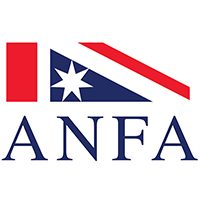The Australian National Flag has a dark blue field with the Union Jack occupying the upper hoist, a large white star in the lower hoist and five white stars in the form of the Southern Cross in the fly. The length of the flag is twice the width.
The flag is made up of a number of parts:
Hoist – The half of the flag nearest to the halyard (that is the rope by which a flag is raised and lowered).
Fly – The half of the flag farthest from the halyard.
Canton – The place of honour in a flag is the upper half of the hoist. It is also called the First Quarter and sometimes the Upper Hoist.
Second Quarter – The upper half of the fly.
Third Quarter – The lower half of the hoist. It is also called the Lower Hoist.
Fourth Quarter – The lower half of the fly.
Making a flag isn’t just about what happens in a flag factory. Two things make a flag: the meaning it has built into it, and the way we respond to those meanings.
A schoolboy, Ivor Evans, one of the five designers of our flag of “Stars and Crosses”, interpreted the stars as symbols of Australia’s bright future, standing for the four moral virtues of justice, prudence, temperance and fortitude.
Ivor Evans loved to write and quote great poets such as Dante. He believed that a flag, flying in the breeze, was in many ways like a ‘physical poem’. A flag’s poetic symbolism is to be honoured by the people whom it represents and by so doing those same people bring honour to themselves by their show of unity.
In the end, flags are what we make of them. Honouring the flag means living up to the ideals it represents, as many Australians have done in the past, so that we too may contribute to the growth of this nation, living together in fairness, equality, with opportunity for all.
